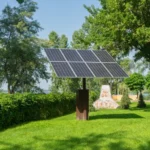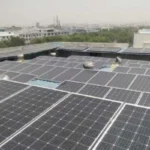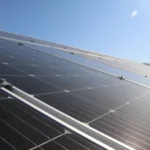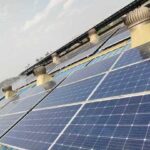India’s Renewable Energy Revolution: The Role of Agrivoltaics
India’s Renewable Energy Revolution: The Role of Agrivoltaics
The International Institute for Sustainable Development (IISD) recently published a report outlining different business models that can help India overcome the challenges of implementing agrivoltaics, a practice where solar panels are installed on agricultural land.
The report suggests three specific models:
- Joint ownership between farmers and developers
- Sole ownership by either party
- Developer-led partnerships with farmers.
Currently, India has around 14,636.6 kW of agrivoltaics capacity in the pilot stages. The report emphasizes the difficulties faced by Indian farmers and developers in adopting agrivoltaics and recommends following the third model, where developers take the lead and farmers become partners. However, this model is only suitable for barren or uncultivated areas due to poor land productivity or state ownership.
Around 53% of India’s land area is classified as arid or semi-arid, and most solar power capacity is installed in such regions with low cropping intensity. These areas, along with peri-urban regions, are favorable for agrivoltaics. However, successful implementation requires proximity to markets for high-value horticultural products.
The report suggests that state governments introduce land-use regulations and define clear standards for agrivoltaics. Different market mechanisms and tariff structures should also be explored to support agrivoltaics.
The use of bifacial solar panels is recommended in Indian agrivoltaic projects as they reduce shading effects, increase power generation, and offer more crop choices.
Integrating rainwater harvesting structures with agrivoltaics is also seen as a promising solution. However, further research and peer learning are necessary due to India’s unique weather conditions. Battery storage is an option for energy storage, but alternative technologies should be considered for farmers who cannot afford it.
Most agrivoltaic pilots in India, initiated under the Pradhan Mantri Kisan Urja Suraksha evam Utthaan Mahabhiyan (PM-KUSUM) program, have not yet grown mainstream crops like paddy and wheat. Proper planning is required to ensure solar panels do not hinder crop production. The report also suggests exploring the option of open access, where developers can directly sell power from agrivoltaic projects to consumers at agreed-upon prices.
Countries like China, Germany, France, and Japan are actively promoting and updating designs and standards for agrivoltaics. They integrate solar panels with different farming systems, such as greenhouses and conventional open farming systems, to adapt to diverse agricultural activities and weather conditions. These countries have a cumulative installed agrivoltaics capacity of approximately 2.5 GW. Italy and France also have significant investments in agrivoltaics.
The report concludes that grid-connected agrivoltaic systems are more scalable than off-grid systems due to higher power production. However, adequate evacuation capacity and proximity to substations are crucial for grid-connected renewable energy to minimize losses. Exploring these aspects in Indian agrivoltaics is an area that requires further exploration.
Suggested Articles

Yes, I Have Installed an Optimized Solar PV Rooftop System at My Premises
A solar power generating system converts sunlight into electricity for residential, industrial, and commercial use. This blog explains the components, working, and benefits of solar systems, helping you understand how to harness solar energy efficiently and sustainably.

Solar Power Park Scheme: Central Government Expands Clean Energy Initiative
The Union government plans to launch the second phase of a dedicated program to develop solar parks across the country that will aim to plug loopholes and overcome slow progress.

Haryana and UP Face Delays in Solar Net Metering Approvals
Net metering for rooftop solar in Haryana and Uttar Pradesh faces procedural delays, affecting solar adoption and efficiency for residential and commercial consumers

Solar Power Set to Overtake Coal as World’s Largest Energy Source in Four Years
Solar power has come a long way in the past decade, moving from being an also-ran to one of the major players in the global energy race. According to the International Energy Agency, next year, solar photovoltaic capacity will surpass hydropower, followed by gas-fired generation in three years and coal in four years.

India Solar Energy Policies: Key Updates and Government Initiatives
India is one of the leading countries in terms of solar energy development, having become the fastest-growing market for solar power globally.

Everything You Need to Know About Solar PV Modules
Solar PV modules explained: how they generate electricity, their benefits, and why they’re key to renewable energy growth.

How DISCOMs Implement Net Metering for Solar Power Plants
Discover the process of net metering implementation by DISCOMs for solar power plants. Understand the benefits, billing mechanism, and how it maximizes solar energy utilization.
Researchers Propose New Way to Make Nuclear Power Plants Safer
Researchers propose innovative methods to enhance the safety of nuclear power plants, aiming to reduce risks and improve operational security.